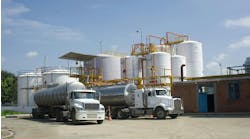Clark: Predictive maintenance: A fleet’s crystal ball for controlling costs
The ability to recognize a potential problem before it materializes is important in life as well as in business. For instance, health issues caught early can be treated to prevent bad outcomes and hopefully lead to a longer, healthier life. When it comes to the health of fleets, the same is true. Recognizing and dealing with vehicle problems early can avoid unexpected breakdowns and costly repairs later down the road.
At a time when global uncertainty exists, predictability is invaluable. Predictive maintenance is a crucial step to mitigate the disruption that comes from uncertainty. With new trucks as expensive as they are, fleets may want to hold on to a larger portion of their fleet for an extended period until they feel more comfortable with economic conditions. That necessitates extending the lifecycle of each vehicle in their fleet.
The role of predictive maintenance in extending the lifecycle of a truck
In an era defined by technological advancements, predictive maintenance stands out as a critical tool for maximizing the longevity and efficiency of truck fleets. By harnessing real-time data analytics, fleet managers can identify potential issues before they escalate, minimizing downtime and costly repairs. This proactive approach optimizes operational reliability and enhances overall fleet management strategies, ensuring vehicles remain in peak condition throughout their lifecycle.
Beyond simply reacting to breakdowns, predictive maintenance allows fleets to take a more structured and strategic approach to vehicle upkeep. With access to real-time diagnostic data, fleet managers can shift from reactive to proactive maintenance scheduling, ensuring minor issues do not become costly mechanical failures. This shift improves budgeting accuracy, reduces unplanned expenses, and extends each vehicle's operational lifespan.
Additionally, predictive maintenance plays a significant role in sustainability efforts. Well-maintained vehicles operate more efficiently, reducing fuel consumption and emissions. By keeping trucks in optimal condition, fleets can meet environmental standards while also benefiting from cost savings.
See also: Clark: AI is already driving your fleet—are you ready to catch up?
Key benefits of predictive maintenance
- Minimizing downtime: Every fleet manager knows the cost to a business when a truck is off the road due to unplanned maintenance issues and/or breakdowns. From disruption in the supply chain to needing replacement vehicles to damaged customer relationships from missed deadlines, the costs are clear. Predictive maintenance helps identify potential issues before they escalate, so fleet managers can schedule maintenance during planned downtime.
- Reducing repair costs: By identifying and addressing potential failures early, fleets can avoid costly emergency repairs and extend the lifespan of critical components. Routine maintenance based on predictive insights allows for more cost-effective repairs compared to emergency fixes.
- Enhancing efficiency: A data-driven maintenance strategy ensures trucks operate at peak performance, improving fuel efficiency and overall productivity. An optimized fleet leads to better route planning, timely deliveries, and fewer disruptions.
- Improving safety: Detecting issues before they become major failures helps reduce the risk of accidents and ensures compliance with industry regulations. Well-maintained vehicles experience fewer mechanical failures that could pose safety hazards on the road.
- Maximizing asset value: Well-maintained vehicles not only last longer but also retain higher resale value, making predictive maintenance a smart investment for any fleet. Buyers in the used truck market place a premium on vehicles with well-documented maintenance records and minimal major repairs.
How AI is playing a major role in predictive maintenance
Artificial intelligence has revolutionized predictive maintenance by enabling sophisticated data analysis and pattern recognition. By continuously processing vast amounts of sensor data and historical maintenance records, AI algorithms can detect subtle anomalies and predict component failures with remarkable accuracy. This proactive maintenance strategy not only reduces maintenance costs but also enhances safety and operational efficiency, making AI a cornerstone of modern fleet management practices. AI’s ability to integrate with telematics and other devices provides real-time diagnostics and alerts that empower fleet managers to take immediate action when needed.
As technology advances, predictive maintenance will continue to evolve, offering even greater accuracy and efficiency. Fleets that embrace AI-powered predictive maintenance solutions will be better positioned to navigate industry challenges, reduce costs, and extend the lifespan of their assets. Investing in predictive maintenance today means investing in a more stable, efficient, and profitable fleet operation for the future.



